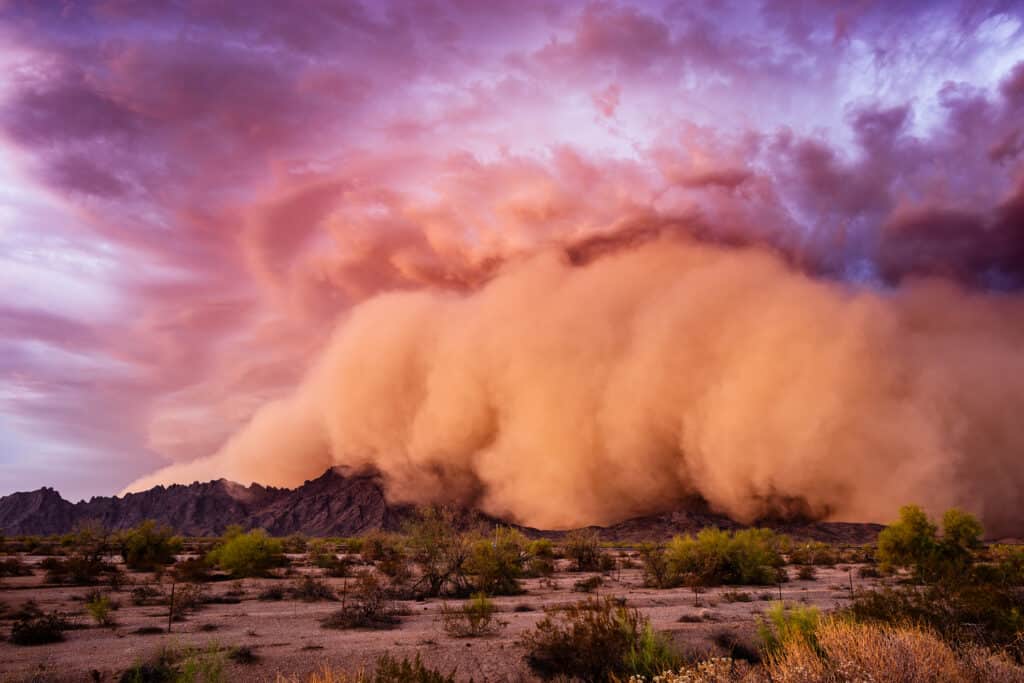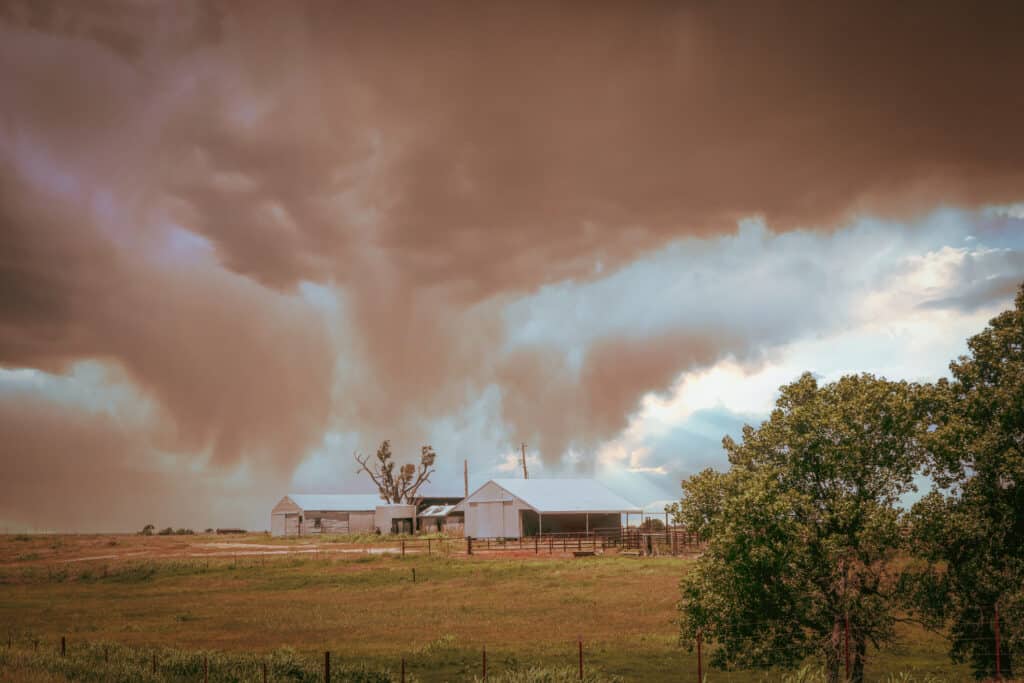It’s 1935 in middle America, and a storm rages outside, rattling your farmhouse walls. Dust spills inside from every nook and crevice, coating the floors and counters. The rag you hold to your face is already dirty, and you choke as you try to gasp for fresh air. Imagine enduring this feeling for a decade!
Dust storms may not seem like a big deal in modern times, but they are capable of causing local and widespread destruction. The Dust Bowl lasted from 1930 to 1940, killing 7,000 people, leaving hundreds of thousands homeless, and completely decimating the agricultural business. Are there still dust storms in Texas? Discover where they happen the most and if we could face another Dust Bowl in the future.
What Are Dust Storms?

Drought, wind, and dryland farming cause dust storms.
A dust storm, also called a sandstorm, is a wall of dust, sand, and debris blown into an area by strong winds. This phenomenon is common in arid and semi-arid regions, like the Southwestern United States, the Middle East, and North Africa. Dust storms happen more frequently in late winter and early spring and can create dust walls miles long and several thousand feet high, completely encompassing homes and businesses.
Dust storms occur when powerful winds, typically produced by thunderstorms, kick dirt from the flat, dry ground into the air. Sandstorms need room to build momentum, and the fewer objects in their path, the more they can increase wind speed and pick up more dust. It is unlikely for a dust storm to form when an area has trees, plants, and rolling hills.
Drought and wind combined with dryland farming involving intensive tillage cause dust storms. High wind speeds and prolonged droughts cause dust particles to loosen from the ground. When gust fronts move into areas with loose dirt, the particles begin to vibrate before proceeding across a surface in a process called saltation.
Why Are Dust Storms Dangerous?

Dust storms cause car accidents, mechanical failures, flight delays, and health problems.
©iStock.com/mdesigner125
Dust storms can have severe short-term and long-term effects. These giant dirt walls catch people off guard and can cause car accidents, reduce visibility for pilots, and generate mechanical failures. They can also spur asthma attacks for those with breathing difficulties.
Surprisingly, these storms can also increase the spread of disease worldwide. The strong winds can blow virus spores into the atmosphere, which mix with air pollution. People who encounter prolonged exposure to dust particles can develop dust pneumonia, lung disease, and cancer. Severe dry eyes are also a common problem and can lead to blindness in extreme cases.
Environmentally, dust storms can significantly reduce agricultural productivity by causing soil loss, removing organic matter, and damaging young crops. But saltation can also be beneficial to agriculture. It can deposit highly fertile soil in regions that need it, causing more crops to grow in the future.
Where Do Dust Storms Happen the Most in Texas?

Dust storms are more prevalent in the High Plains around Lubbock.
©iStock.com/Patricia Elaine Thomas
Dust storms in Texas can happen any time of the year and across most of the state. However, they are more prevalent in the High Plains around Lubbock during late winter and early spring. These storms are still prevalent today, creating looming, thick walls that block out the sun, 60 mph winds, and zero visibility. West and North Texas typically get hit the hardest in desert areas after a cold front. The amount of dust storms in Texas varies, but around 5 to 25 occur annually.
What Happened During Black Sunday?
Black Sunday refers to the Dust Bowl’s worst storm and one of the worst in American history. On April 14, 1935, a dust storm nicknamed “black blizzard” blew through parts of Kansas, Colorado, New Mexico, Oklahoma, and Texas. But the worst of the storm centered around the Oklahoma and Texas panhandles.
Personal accounts of the day describe a monstrous cloud, hundreds of miles long and black as night, descending upon farming communities. People couldn’t see their hands in front of their faces; some even suffocated to death. It caused massive economic and agricultural damage, displacing 300,000 tons of soil. Shortly after Black Sunday, hundreds of thousands of people relocated.
What Should You Do During a Dust Storm?

It is necessary to always heed storm warnings and stay indoors.
©iStock.com/Susan Vineyard
Dust storms can be dangerous. Check out these tips for staying safe.
- If you’re driving when a storm approaches, immediately slow down, pull off to the side, and turn off your car’s lights. Keep your seatbelt on and ensure all windows are rolled up and vents are closed.
- If you’re at home, close all windows, doors, curtains, and blinds. Turn off the air conditioning and shut any vents. Preferably, stay in a room without windows.
- If there’s time, remove things from your property that could become flying debris.
- Always heed storm warnings and stay indoors. If you can’t make it home in time, shelter in a nearby building.
Could the Dust Bowl Happen Again?
Summer in 1936 was once the hottest in US history, but not anymore. The summer of 2021 broke that record for the first time. In fact, the last seven years have been the hottest in recorded history. The heat waves in the 1930s helped propel the Dust Bowl, but scientists believe it is 2.5 times more likely to happen in our modern climate. Their study concluded that even if we take steps to mitigate climate change today, it may not be enough to prevent a second Dust Bowl.
Up Next…
- Sand Dunes in Texas
- The 7 Worst Flash Floods in Texas History
- The 12 Largest Ranches in Texas
- What’s the Largest County In Texas – and What Makes it Unique?
The photo featured at the top of this post is © iStock.com/mdesigner125
Thank you for reading! Have some feedback for us? Contact the AZ Animals editorial team.







